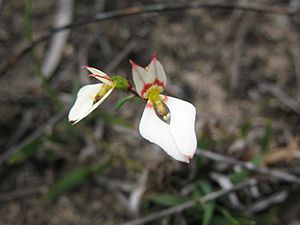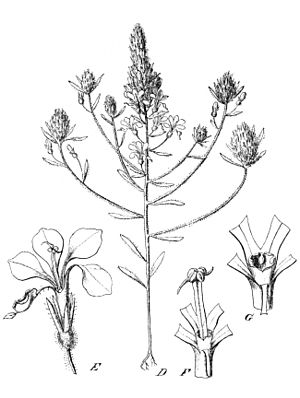Styleworts facts for kids
Quick facts for kids Styleworts |
|
|---|---|
 |
|
| Levenhookia pauciflora | |
| Scientific classification |
|
| Kingdom: | Plantae |
| Clade: | Tracheophytes |
| Clade: | Angiosperms |
| Clade: | Eudicots |
| Clade: | Asterids |
| Order: | Asterales |
| Family: | Stylidiaceae |
| Subfamily: | Stylidioideae |
| Genus: | Levenhookia R.Br. |
| Sections and species | |
|
Coleostylis
Estipitatae
Levenhookia
|
|
| Synonyms | |
|
|
Levenhookia, also called styleworts, is a group of ten plant species. These plants belong to the Stylidiaceae family. They are found only in Australia, meaning they are endemic there.
Most Levenhookia species grow in Western Australia. However, a few types are found in other parts of Australia. For example, L. pusilla also grows in South Australia. L. dubia can be found in South Australia, Victoria, and New South Wales. L. sonderi only grows in Victoria. L. chippendalei is also found in the Northern Territory.
What Makes Levenhookia Special?
All Levenhookia plants have a special part called a labellum. This labellum is very sensitive to touch. It works like the "column" in Stylidium plants. When an insect touches the labellum, it moves. This movement helps the plant share its pollen with other plants. This process is called cross-pollination. It helps the plants avoid pollinating themselves.
Most Levenhookia species are ephemeral plants. This means they grow quickly and then die. They prefer to grow in sandy areas called heath habitats. Levenhookia plants also have sticky hairs called trichomes. These hairs are similar to those on their close relatives, the Stylidium plants. Scientists think Levenhookia might be carnivorous, like some Stylidium species. However, no studies have fully proven this yet.
How Levenhookia Evolved
The Levenhookia genus is closely related to the Stylidium genus. Scientists believe Levenhookia likely evolved from Stylidium plants. This happened through a process called outcropping. This means new species formed by growing in different areas.
One example of this evolution can be seen in how they pollinate. L. preissii needs pollen from another plant to reproduce. But L. dubia can pollinate itself if needed. Some Stylidium species have even developed flowers that look like Levenhookia flowers. This helps them attract the same insects for pollination. For instance, S. xanthopis looks like L. leptantha. Also, S. ecorne looks like L. pauciflora.
In 1908, a scientist named Johannes Mildbraed divided the Levenhookia genus into three main groups, or sections. These sections help scientists organize the different species.
- Section Coleostylis includes L. chippendalei, L. preissii, and L. stipitata. It might also include L. octomaculata.
- Section Estipitatae includes L. dubia, L. leptantha, and L. sonderi.
- Section Levenhookia includes L. pusilla and L. pauciflora. It could also include L. pulcherrima. This section was originally called Eulevenhookia. It was later changed to Levenhookia because it is the main group for the genus.
See also
 In Spanish: Levenhookia para niños
In Spanish: Levenhookia para niños


